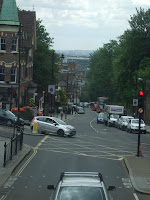Chiswick (Grove Park) to Shepherd’s Bush Station
Tuesday December 27th 2011
Tuesday December 27th 2011
The bus expedition today, including two male relatives both keen to try their respective technologies of I-Phone and new camera, had met earlier in Mitcham and given the light Bank Holiday traffic we were soon at Putney Bridge. After a delay while, rather as in the old Music hall ditty, an old lady got locked in a lavatory in Bishops Park, the party advanced on foot in an effort to walk off a few Christmas meals taking in the considerable curve of the north bank Thames Path to Chiswick where the petite 272 waits in a quiet residential street.
Technically this part of Chiswick goes by the name of Grove Park, but doubtless in order to avoid confusion with SE London’s own Grove Park the nearby railway station is firmly called Chiswick. Compared to the grand riverside residences of the Eyot (island to you and me), this is less posh Chiswick but that still makes it a more expensive area than the start of most of our routes. Grand houses, mostly now sub-divided into flats, and the open spaces of the Quintin Hogg Playing Fields line wide and quiet avenues. The original philanthropic Old Etonian who founded the Regent Street Poly all those years ago might be a little surprised to find it was now the University of Westminster with its playing fields out here…
The bus passes back to the station along two very pleasant wide roads bordered by grand homes and we arrived at the Station House, formerly perhaps a station hotel. The front looks very grand but we had been round the back where the sight of dustbins and unswept leaves was less appetising.
Back to the Chiswick back streets. Jo was convinced we would be the only passengers but she was soon proved wrong. Three giggly girls got on, not seeming to know the cost of travel, and I had them earmarked as travelling to spend their Christmas money at Westfield. Other passengers soon boarded. Grove Park was named after a larger older manor house and the same is true of Sutton Court Road; Sutton Court had been the largest manor hereabouts and after changing hands several times was finally demolished to be replaced by the current fine flats in 1905.
Suttton Court Road brought us out at the corner of Turnham Green, one of my favourite London greens, much enhanced by the Giles Gilbert Scott church; we were not sure what the building on the corner might be with its canopies and proud façade it looked as though it might have some civic purpose?
The bus dives into the side streets, where the rather nasty Chiswick Health Centre (perhaps converted from a car park?) is thankfully hidden away, and we soon drove parallel to Chiswick Common Green and saw the two railway lines – an argument amongst the party as to which tube line this might be proved we were both right as the Piccadilly and District run close to each other.
Acton Green and the Tabard pub all border the conservation area that is Bedford Park, again built as a cohesive whole rarely bettered; we fell for the Dutch gables and other properties along the Bath Road, many of which are now listed. This is a route, which could only be taken by a slim single decker, as several times we had to obey ‘Give Priority to Oncoming Traffic’ signs. The Tabard itself was built by the Victorians in a country pub style; even they apparently tired of those huge edifices and hankered after the nostalgic ‘village pub’ look...
More architecture attracted our attention – this time at the modern end of the spectrum in the shape of the
'Factory Quarter' development, apparently built on the site of the former Prestolite factory. Prestolite was a US company, which took over from Lucas who made components for diesel engines but soon after the take-over (sounds familiar?) the factory closed now only to be remembered in the development’s name.
From here the 272, which has been pretty much on its own, has a brief foray onto the Uxbridge Road alongside other routes like the 266 and the famous ‘non stop’ 607.
Continuing along Old Oak Road was again familiar territory but it made a change to approach it from this direction and the landmarks came thick and fast: Newman set and prop hire, the Angel (Askew) Pub, a play on the road name, and, just approaching Sandy corner and East Acton Station, a row of workers’ cottages looking truly out of place by now.
After doing the little loop round Brunel Road, the ‘run in’ to Shepherds Bush was even more familiar with firstly the homes for prison workers then the listed buildings of Wormwood Scrubs closely followed by student flats , Hammersmith Hospital and Latymer Schools and playing fields. All these are strung along du Cane Road, named for the prolific architect Edmund du Cane, a son of Plymouth.
Once under Westway and into Wood Lane the BBC dominates with buildings of various vintages and grandeur. The extent of the site made us question why droves of people had been sent to Salford? Will the BBC sell off the spare office/studio space?
Sure enough as the stops for Westfield shopping were announced our passengers who had boarded with us in Chiswick got off, as did most people. In fact the last two stops taking us round 2½ sides of Shepherds Bush Green were the slowest probably due in part to the seasonal fair complete with a Walzer few us of could even bear to look at.
All the fun of the fair indeed. As befits our age we more enjoyed the range of architectural delights available to us on this circuitous but charming route.


































